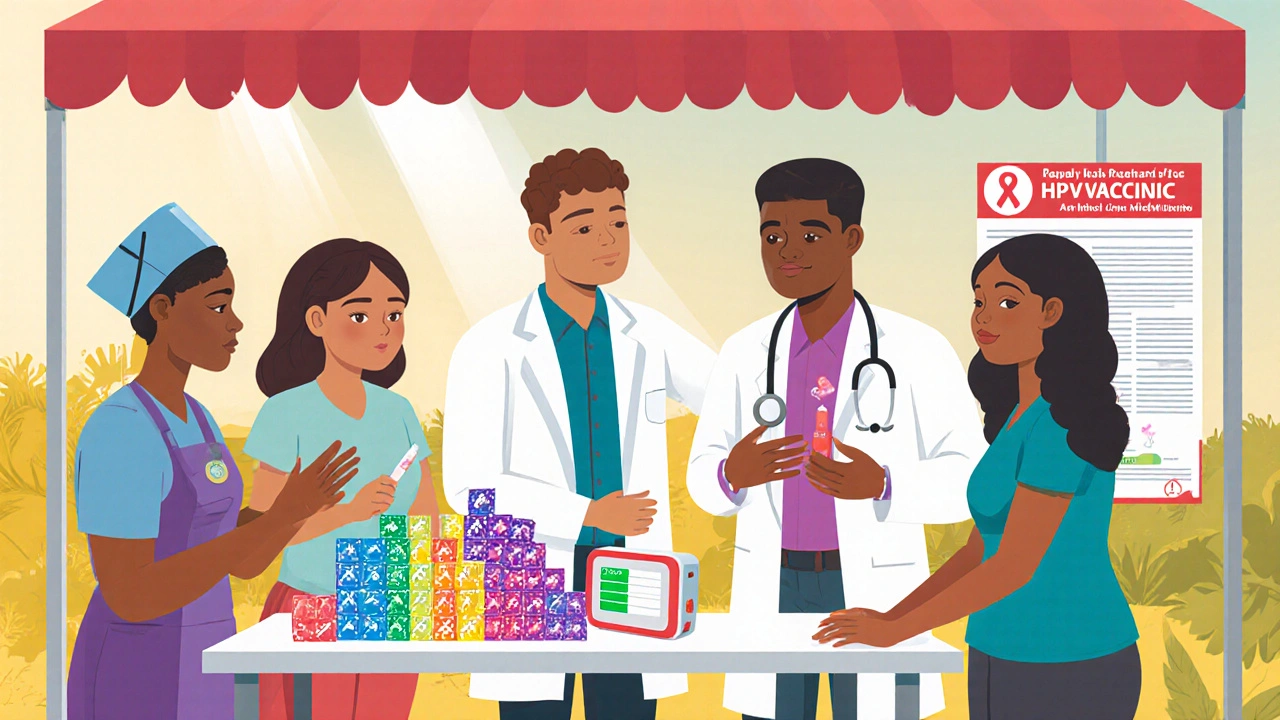STI Risk Assessment Calculator
Assess Your STI Risk
Answer the following questions to get personalized risk feedback and prevention recommendations.
Enter your information and click "Calculate My Risk Level" to see your personalized risk assessment.
Sexually transmitted infections affect billions of people worldwide, yet many still think they’re a problem for a few. In reality, every continent faces rising rates, and the ripple effects reach economies, families, and future health.
Key Takeaways
- Over 1 million new STI cases are reported daily, with the highest growth in low‑ and middle‑income regions.
- Asymptomatic infections drive hidden transmission; regular testing cuts spread dramatically.
- Condom use, HPV vaccination, and rapid point‑of‑care tests are the most effective preventive tools.
- Antibiotic resistance is turning treatable STIs into long‑term health threats.
- Coordinated public‑health campaigns and community‑based contact tracing save lives and resources.
Understanding the Scale
Recent data from the World Health Organization the UN agency that monitors global health trends and sets standards for disease control show that more than 376million new infections of chlamydia, gonorrhea, syphilis and trichomoniasis occurred in 2023 alone. The Centers for Disease Control and Prevention the U.S. federal public‑health agency that tracks infectious disease outbreaks and provides guidance reports a 25% rise in reported cases of gonorrhea in the United States over the past five years.
These numbers matter because untreated STIs can lead to infertility, chronic pain, increased HIV risk, and complications during pregnancy. The economic burden is staggering: the World Bank estimates a $16billion annual cost for STI‑related health care and lost productivity in low‑income nations.
Why Infections Keep Spreading
Three forces keep the epidemic alive.
- Silent carriers: Up to 70% of chlamydia infections show no symptoms. People feel fine, skip testing, and unknowingly pass the pathogen to partners.
- Drug‑resistant strains: Antibiotic resistance the ability of bacteria to survive medicines that once killed them, rendering standard treatments ineffective is now common in gonorrhea, with strains resistant to ceftriaxone emerging in 2022.
- Access gaps: Rural clinics, stigma, and lack of affordable testing kits limit early diagnosis, especially in sub‑Saharan Africa and Southeast Asia.

The Prevention Toolbox
Preventive measures are most powerful when combined. Below is a quick look at the top tools.
| Method | Coverage | Cost (per use) | Effectiveness |
|---|---|---|---|
| Condom | All STIs | $0.20-$0.50 | 80‑95% |
| HPV Vaccine | HPV only | $150-$200 (full series) | ≈99% for targeted strains |
| Regular Testing | Detects asymptomatic cases | $30-$100 per panel | Depends on test sensitivity; PCR >95% |
| Education Campaigns | Behavior change | Variable (public‑funded) | Improves condom use by 20‑30% |
Condoms remain the cheapest and most versatile barrier. The HPV vaccine a preventive injection that protects against human papillomavirus strains causing cervical cancer and genital warts has cut HPV‑related cancers by half in countries with high coverage.
Testing is the only way to catch silent infections. Rapid point‑of‑care nucleic‑acid tests now give results within 30minutes, making same‑day treatment possible.
Treatment Challenges and Emerging Solutions
When an STI is caught early, antibiotics or antivirals usually clear it. But the rise of drug‑resistant gonorrhea means clinicians are scrambling for alternatives.
Researchers are testing new molecules such as zoliflodacin and gepotidacin, which target bacterial enzymes not affected by existing drugs. Early trials show 95% cure rates against multidrug‑resistant strains.
Telemedicine platforms are also shifting care. Patients can order home‑testing kits, receive digital results, and get prescription meds delivered within a day, reducing the barrier of clinic visits.
Public‑Health Leaders in Action
Coordinated action from global and national agencies fuels progress.
The World Health Organization the UN agency that monitors global health trends and sets standards for disease control launched the “Global STI Strategy 2025‑2030,” aiming to halve new infections by 2030 through expanded testing, vaccine roll‑outs, and resistance surveillance.
In the United States, the Centers for Disease Control and Prevention the U.S. federal public‑health agency that tracks infectious disease outbreaks and provides guidance runs the STD Surveillance Network, which collects real‑time data to spot outbreaks early and guide resource allocation.
Regional programs, such as Africa’s “Strengthening STI Services” initiative, train community health workers to distribute condoms, provide rapid tests, and educate youths in schools.

Community‑Driven Steps You Can Take
Individual actions still matter. Here’s a simple checklist you can follow.
- Get tested at least once a year, or more often if you have new partners.
- Use a condom a barrier device made of latex or polyurethane that prevents direct contact with bodily fluids for every sexual encounter.
- Ask partners about their testing status and share your results openly.
- Consider the HPV vaccine a preventive injection that protects against human papillomavirus strains causing cervical cancer and genital warts, especially if you’re under 26years old.
- Participate in local education campaigns or volunteer for contact‑tracing efforts.
Contact tracing, a practice borrowed from COVID‑19 control, helps identify exposed partners quickly. When done confidentially, it reduces stigma and stops chains of transmission.
Looking Ahead: The Next Decade
Future breakthroughs could reshape the STI landscape.
- Universal rapid tests: Portable devices that detect multiple pathogens from a single swab could make community‑based screening routine.
- Next‑generation vaccines: Research into a pan‑HPV vaccine and a gonorrhea vaccine is gaining momentum, with phase‑II trials expected by 2027.
- AI‑driven surveillance: Machine‑learning models that analyze social media, pharmacy sales, and clinic data can flag emerging hotspots faster than traditional reporting.
None of these advances will work without sustained funding, political will, and public trust. Continued collaboration between governments, NGOs, and private innovators is the only path to a world where STIs are rare, treatable, and no longer a hidden burden.
Frequently Asked Questions
What are the most common sexually transmitted infections today?
Chlamydia, gonorrhea, syphilis, trichomoniasis and human papillomavirus (HPV) are the five infections that account for the majority of new cases worldwide.
Why is regular testing so important if I feel fine?
Many STIs, especially chlamydia and gonorrhea, often show no symptoms. Testing catches these hidden infections, allowing treatment before they spread or cause complications.
How effective are condoms at preventing STIs?
When used correctly, condoms reduce the risk of most STIs by 80‑95%. They are the only method that protects against a broad range of bacterial, viral, and parasitic infections.
Is antibiotic resistance a real threat for STIs?
Yes. Resistant strains of gonorrhea are now reported on every continent, and treatment failures are increasing. This makes research into new drugs a public‑health priority.
Can vaccines prevent STIs?
The HPV vaccine prevents infections that cause most cervical cancers and genital warts. Ongoing trials are testing vaccines for gonorrhea and other pathogens, which could add powerful tools to the prevention toolbox.
What should I do if I think I’ve been exposed to an STI?
Seek testing as soon as possible-many clinics offer same‑day results. If a test is positive, start the recommended treatment promptly and inform recent sexual partners so they can get tested and treated.


Naomi Ho
October 10, 2025 AT 18:47Here’s a quick rundown on how to use the risk calculator effectively. First pick the right frequency for your STI tests, the more often the better. Then be honest about condom use and whether you’ve completed the HPV series. Finally, count your partners for the past year and hit calculate to see your personalized risk level.
Christine Watson
October 12, 2025 AT 07:24Great job sharing this tool! It’s super helpful for anyone who wants to stay on top of their sexual health. Keep the positivity flowing and remember, knowledge is power, so keep checking in regularly.
Macy Weaver
October 13, 2025 AT 20:02I love how this calculator encourages open conversation about STI prevention. It’s important we all feel safe discussing testing frequencies and condom habits without judgment. By sharing our experiences we can all learn better strategies and support each other in making healthier choices.
James McCracken
October 15, 2025 AT 08:39One might argue that a simple scoring system reduces a complex web of human behavior to a number, yet perhaps that reduction is precisely what makes public health messaging possible. If we obsess over nuance in every case, we risk paralysis. So, a straightforward rubric, even if imperfect, can spark action where inaction would otherwise linger.
Sunil Kamle
October 16, 2025 AT 21:16Ah, the elegance of a highly formal, yet sarcastically worded reminder: surely you all were awaiting a pearl‑laden lecture on why condom usage is a mere suggestion. In reality, the data is unequivocal-consistent condom use slashes transmission rates, and the calculator merely quantifies what common sense already tells us.
Steve Helsel
October 18, 2025 AT 09:54Honestly, this looks like a gimmick.
Steve Moody
October 19, 2025 AT 22:31First and foremost, let me commend the developers for curating a tool that is, undeniably, a step forward in public health outreach; however, one must also acknowledge that the interface, while functional, could benefit from a more intuitive user experience, particularly in the realm of data entry, where dropdown menus sometimes appear to lag. Moreover, the weighting algorithm-assigning two points to testing frequency and HPV vaccination, yet only a single point to condom usage-raises questions about the underlying epidemiological assumptions, which, if misaligned, could inadvertently misinform users regarding risk stratification. In practice, consistent condom usage has been shown to drastically reduce transmission rates for a multitude of pathogens, suggesting perhaps a recalibration of weightings is warranted. Additionally, the language employed throughout the questionnaire maintains a commendably neutral tone, yet an occasional insertion of clarifying examples-such as defining “more than once a year” testing as semi‑annual-could enhance comprehension among diverse demographic groups. It is also worth noting that the visual design, while clean, could integrate more vibrant color cues to signal risk levels, thereby facilitating quicker user interpretation. Finally, ongoing validation studies, ideally published in peer‑reviewed journals, would solidify the credibility of this calculator and encourage broader adoption across clinical settings; until such data is publicly available, a measured degree of skepticism remains prudent.
Adrian Hernandez
October 21, 2025 AT 11:08Sure, let’s trust a web form while the big pharma lobby decides which diseases get real attention. Meanwhile, they’re probably mining the data for something else entirely.
duncan hines
October 22, 2025 AT 23:46Whoa, hold the phone! This is like, the drama of the decade-people actually *think* a calculator can replace a real doctor! (seriously, the typos are real, hah)
Chris Meredith
October 24, 2025 AT 12:23From a public‑health perspective the calculator injects a dash of quantitative insight into community outreach; that said, the real clincher is ensuring that these digital tools are paired with culturally resonant education campaigns, otherwise the data remains underutilized. In resource‑constrained settings, leveraging mobile penetration can amplify impact, provided we keep the UI lightweight and jargon‑free.